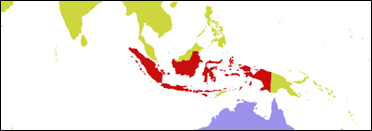Indonesia is a unitary state adopting a Republic System consisting of seventeen thousand islands with the total area of almost 2 million square km (about 40% of the EU’s territory) and a population of 247 million inhabitants.
Since 2001, the country has launched a strong process of decentralisation, expanding the number of provinces to 33. However, according to the OECD, decentralisation needs to be reinforced through better co-ordination[1]. Local governments are headed by governors for a province, Bupatis for municipalities or mayors for cities. Since January 2001, Indonesia has been implementing new Laws on Local Government and Intergovernmental Fiscal Balance which are popularly known as “Autonomy Laws”. The Laws were revised in 2004, and one of significant changes is that Bupati and Mayor since then are directly elected by citizens. Except for the areas of defence, foreign affairs, religion affairs, justice, monetary, fiscal and macro-economic policies that are in the hand of national government, the rest of government functions are given to the local authority. Even though the new era of decentralisation legally characterises involvement of public participation in local policies, it is not fully implemented.
Urban development: Urbanization in Indonesia increased tremendously following the country’s rapid development in the 1970s. Since then, Indonesia has been facing high urbanization rate driven by rural-urban migration. As mentioned in the TOR, in 1950, 15% of Indonesia’s population lived in urban areas. By 2025, approximately 67.5 percent of its population will live in urban areas. Indonesia has been entering an urban era, marked primarily with the real fact of growing high-speed level of people settled in cities (see Kirmanto et al – below). Similar phenomenon has happened in most of Asian countries in the post-war years, as consequence of a massive economic growth. Such fast urban transformation has not been simple to manage.
Climate change adds more pressure and complexities to urban problems. Some impacts of climate change have already occurred, mostly in cities located in low-lying coastal areas, such as water crisis, tropical storms, sea level rise, and flooding in coastal areas. To give few illustrations, it is predicted that about 25 national growth centres and 84 regional growth centres are at high risk to coastal inundation[2]. Furthermore, there are 18 national centres, including Semarang, Surabaya and Banjarmasin, are to be at high risk to flooding due to high intensity of rainfall combined with high social vulnerability. In some cities, water crisis remains a serious threat. It would worsen if climate change parameter is included.
Indonesia is committed to 29% emission reduction from the Business-As-Usual (BAU) emissions scenario by 2030 and an additional 12% reduction from BAU by 2030 subject to the provision of international support. To this end, Indonesia is committed to capacity building at the local level and enhanced urban waste and wastewater management policies, especially waste-to-energy.
One of the main pillars of the 2011-25 Master Plan for the Acceleration and Expansion of Indonesia’s Economic Development (MP3EI) is strengthening national connectivity. Under the terms of the plan, the provision of infrastructure will enable connectivity and, by reducing transportation and logistics costs, improve product competitiveness and accelerate economic growth[3]. MP3EI aims to address regional disparities in infrastructure and ensure connectivity among the six economic corridors (Sumatra, Kalimantan, Java, Sulawesi, Bali and Nusa Tenggara, and Papua-Maluku) through an integrated system of national logistics, transportation, and communication and information.
Extra focus needs to be given to local government capacity building. Increasing resources both from public and private sources as well as improving the regulatory environment are essential measures. They are not, however, enough to complete all the infrastructure investment projects identified by the Master Plan. While infrastructure development activities among ministries and across tiers of government need to be better co-ordinated, there is also room for improvement in local government capacity building.
Best practice: Cities Development Initiative for Asia (CDIA)
CDIA is an international partnership initiative, established in 2007, by the Asian Development Bank (ADB) and the Government of Germany, with additional core funding support from the governments of Austria, Sweden, Switzerland and the Shanghai Municipal Government. The Initiative provides assistance to medium-sized Asian cities to bridge the gap between their development plans and the implementation of their infrastructure investments. The project works around 5 core areas: Urban Environment Improvement, Urban Poverty Reduction, Climate Change Mitigation or Adaptation, Good Governance and Capacity Development. GIZ is a founding member of CDIA and would ensure synergies with their regional activities.
Source: CDIA website
